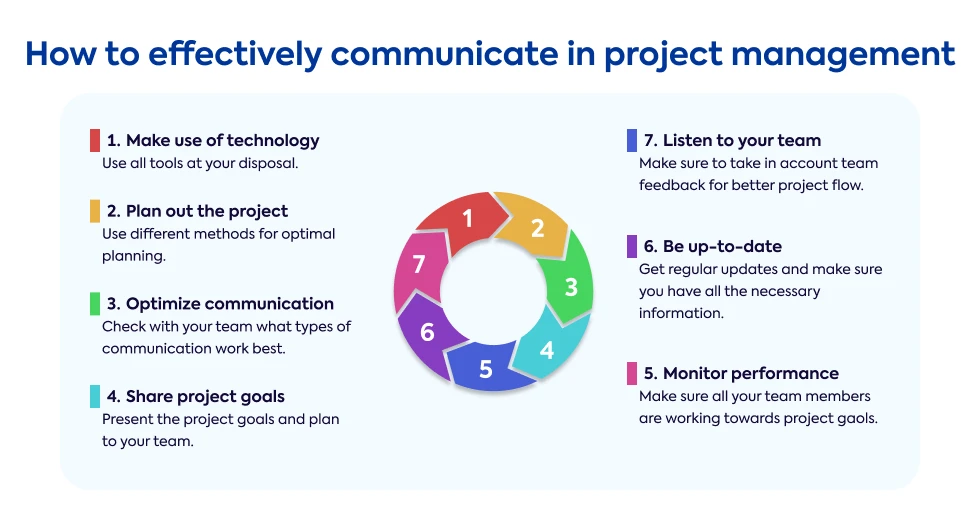TABLE OF CONTENTS:
- Why is communication in project management important?
- Types of communication in project management
- Communication tools
Effective project management requires many essential skills; but the most important among them is good communication.
Communication includes the exchange of information, ideas, and feedback, resulting in focused and timely project outcomes.
It is the backbone of project management, enabling smooth progress and helping the team to stay aligned with project goals.
Without
strong communication skills, project managers can have trouble effectively
leading teams and guiding teams toward project success.
Why is communication in project management important?
Effective communication is crucial in project teams with diverse skills and experiences to keep everyone informed and focused.
Project managers spend a lot of time on communication to drive project success.
It's also vital for everyone involved to improve their communication skills, whether by asking questions to understand project details better or sharing ideas to promote project progress.
Types of communication in project management
In project management, there are four main types of communication:
1. Project Perspective
Internal communication happens among team members who are working directly on the project. This includes discussions, sharing information, and delegating tasks among team leaders and team members.
External communication is the information exchanged between the project team and stakeholders who aren't directly involved in the project tasks. This type of communication is usually more formal since it involves people outside the team.
2. Organizational perspective
Vertical communication happens between different levels of the organization's hierarchy. For example, team members might report issues up to the project manager, who then updates their own boss on the project's progress.
Downward communication occurs when project managers assign tasks to their team members.
Horizontal communication takes place among colleagues at the same level, such as during daily meetings where teams coordinate and plan tasks.
Diagonal communication crosses department lines and is common in complex organizations. For instance, a project manager working on a mobile app might seek advice from someone in the software department to address similar challenges.
In all types of communication, it's crucial for project managers and team members to understand the organization's policies to guide their interactions effectively.
3. Formal Perspective
Informal communication, similar to internal communication, includes daily emails and impromptu meetings. This type of communication is casual and often unplanned.
Formal communication, on the other hand, should be prioritized more. It includes official reports, press releases, and formal meetings with key stakeholders.
4. Channel Perspective
From a channel perspective, communication involves choosing the right medium, such as verbal or non-verbal, in-person or remote, and written or oral.
Each medium has its pros and cons that project managers need to recognize.
For instance, face-to-face communication lets you see body language, which is helpful but often not possible with remote teams. On the other hand, written communication ensures messages are clear and exact, but it can miss the subtleties of verbal exchanges.
Communication tools
Communication can be divided into three categories: verbal, non-verbal and written communication.
Although each is important, you should rely mostly on verbal and written communication.
Chat
The Chat module can be used to communicate with employees, clients, or colleagues, which speeds up the entire communication process.
Main features that chat should have are:
- the possibility of individual and group correspondence
- file sharing
- an unlimited number of participants and chat channels
- the possibility of creating a task from the chat.
An integrated chat option reduces the loss of focus as opposed to using several different external applications.
With fully integrated e-mail you can send and receive e-mails without leaving the user interface.
E-mails are a classic form of office communication, and this module enables quick and easy integration of your e-mail inbox.
Integrated e-mail option allows:
- adding files
- adding documents
- adding signatures
- converting incoming e-mails into leads or tasks.
Conferencing
The conference call module supports virtual calls, meetings, and presentations, enabling real-time document sharing and interaction regardless of distance.
Conferencing options should include:
- audio and video calls
- chat during calls
- a virtual whiteboard for collaborative writing
- online presentations.
Online calls reduce travel costs and include tools for discussions, file sharing, and surveys.
This setup makes meetings more accessible and interactive, simulating an in-room experience.

Face-to-face meetings are still popular in many companies and can be useful, but with the growing number of employees working from home or hybrid, they are becoming increasingly difficult to organize.
Although many tools can replace each of these communication methods, few provide a comprehensive platform with integrated modules to manage all business processes in one place.
Gauss Box is a platform that offers all necessary modules in one place, including other project monitoring and management tools.
